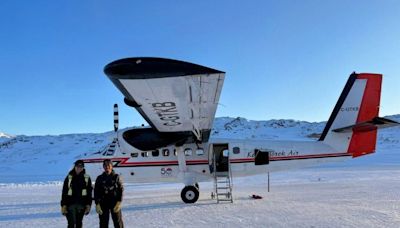Search results
The polar bear (Ursus maritimus) is a large bear native to the Arctic and nearby areas. It is closely related to the brown bear, and the two species can interbreed. The polar bear is the largest extant species of bear and land carnivore, with adult males weighing 300–800 kg (660–1,760 lb).
Jun 29, 2024 · Learn about the polar bear, the largest and most powerful carnivore on land, that lives in the Arctic region and feeds on seals and other prey. Find out how climate change, hunting, and human activities affect its survival and population.
- The Editors of Encyclopaedia Britannica
- A polar bear is a great white northern bear (family Ursidae) found throughout the Arctic region. Except for one subspecies of grizzly bear, the pol...
- Polar bears are mostly carnivorous. They eat the ringed seal as well as the bearded seal and other pinnipeds. Additionally, polar bears are opportu...
- One important adaptation of polar bears to their unique climate is the transparency of their thick fur, which allows sunlight to pass through and r...
- No, polar bears are not an endangered species, but they are threatened. In 2015 the International Union for Conservation of Nature (IUCN) Polar Bea...
The largest bear in the world and the Arctic's top predator, polar bears are a powerful symbol of the strength and endurance of the Arctic. The polar bear's Latin name, Ursus maritimus, means "sea bear." It's an apt name for this majestic species, which spends much of its life in, around, or on the ocean–predominantly on the sea ice.
- Polar bears are classified as marine mammals. Because they spend most of their lives on the sea ice of the Arctic Ocean depending on the ocean for their food and habitat, polar bears are the only bear species to be considered marine mammals.
- A polar bear skin is actually black. Beneath all that thick fur, polar bears have jet black skin. The polar bear’s fur is also translucent, and only appears white because it reflects visible light.
- They can swim constantly for days at a time. As well as reaching speeds of up to 6mph in the water, polar bears can swim for long distances and steadily for many hours to get from one piece of ice to another.
- Less than 2% of polar bear hunts are successful. Although about half of a polar bear’s life is spent hunting for food, their hunts are rarely successful.
- Arctic Adaptations
- Hunting
- Breeding and Behavior
- GeneratedCaptionsTabForHeroSec
Polar bears live in one of the planet's coldest environments and depend on a thick coat of insulated fur, which covers a warming layer of fat. Fur even grows on the bottom of their paws, which protects against cold surfaces and provides a good grip on ice. The bear's stark white coat provides camouflage in surrounding snow and ice. But under their ...
These powerful predators typically prey on seals. In search of this quarry they frequent areas of shifting, cracking ice where seals may surface to breathe air. They also stalk ice edges and breathing holes. If the opportunity presents itself, polar bears will also consume carcasses, such as those of dead whales. These Arctic giants are the masters...
Females den by digging into deep snow drifts, which provide protection and insulation from the Arctic elements. They give birth in winter, usually to twins. Young cubs live with their mothers for some 28 months to learn the survival skills of the far north. Females aggressively protect their young, but receive no help from their solitary male mates...
Learn about the polar bear, a powerful predator that lives in the Arctic ice and depends on seals for food. Find out how climate change, human activities, and natural enemies affect their survival and population.
Learn about polar bears, the largest land carnivores, that live in the Arctic and hunt seals on sea ice. Find out how climate change affects their habitat, diet, and survival.
Learn about the largest living carnivores on Earth, their amazing adaptations, hunting skills and conservation status. Find out how polar bears use their sense of smell, swim, blend in with their surroundings and raise their cubs.





